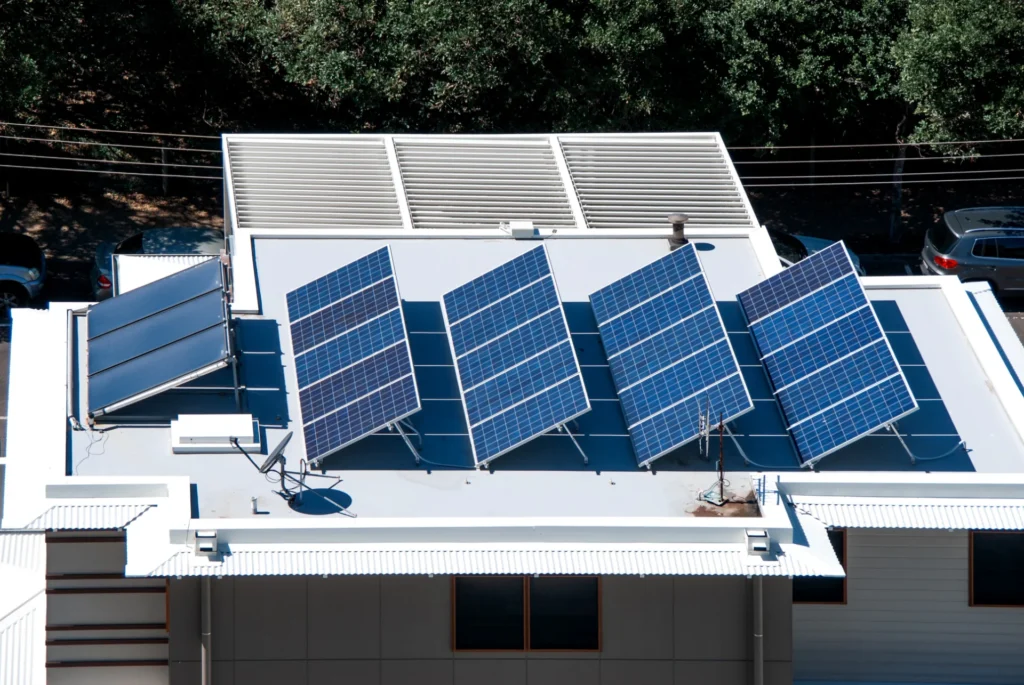
Solar panels are a popular and sustainable energy source many homeowners install on their property. However, some may wonder if solar panels can be installed on a flat roof. The answer is yes. Installing solar panels on a flat roof is possible, but several factors must be considered before deciding.
Before installing solar panels on a flat roof, it is important to understand the orientation and tilt of your roof. The direction your roof faces and its angle will affect how much sunlight your solar panels receive. The type of solar panel you choose and the mounting system will also impact performance. Evaluating your roof’s structure and calculating your energy needs and budget before installing is essential. Furthermore, understanding local regulations and incentives can help ensure compliance with laws while maximizing potential savings. This article will explore these considerations in detail for those interested in installing solar panels on their flat roofs.
The orientation and tilt of a flat roof are crucial factors to consider when determining the feasibility of adopting alternative energy solutions. A solar panel system is designed to capture sunlight for energy production, and the orientation of your roof will determine how much sunlight it receives throughout the day. The ideal orientation for a solar panel system in the northern hemisphere is south-facing, allowing the panels to receive maximum exposure to sunlight. However, east or west-facing roofs can also work well if they receive enough direct sunlight.
In addition to orientation, you must consider the tilt of your flat roof when installing solar panels. The tilt angle determines how much direct sunlight hits each panel and affects efficiency. Ideally, solar panels should be installed at an angle that maximizes sun exposure while minimizing shading from surrounding objects such as trees or buildings. Generally, a tilt angle between 15-40 degrees is recommended for optimal performance.
If your flat roof has a low or no pitch, you may need to install additional equipment, such as racks or mounts, to achieve an optimal tilt angle for your solar panels and maximize sun exposure. This can add complexity and cost to your installation but may be necessary to achieve maximum energy output from your system. Additionally, it’s important to consider any planning permission requirements that may be necessary in your area, as the solar industry is subject to regulations.
Understanding the orientation and tilt of your flat roof is critical in determining whether solar panel installation is feasible and will result in optimal energy production levels. By carefully considering these factors and working with experienced professionals in the solar panel industry who can help you design an efficient system that meets your needs, you can enjoy significant financial savings by reducing reliance on traditional power sources while contributing positively towards environmental sustainability initiatives. Mounting frameless panels at the right degrees is essential for maximum efficiency.
When considering the type of solar panels for your flat roof, it is important to weigh the pros and cons of each option. Monocrystalline panels are known for their high efficiency and durability, while polycrystalline panels offer a more cost-effective solution. Thin-film panels may be attractive due to their flexibility and lightweight design, but they typically have lower efficiency ratings than crystalline options. Ultimately, choosing the right type of solar panel will depend on your specific needs and budget constraints.
A comparison between monocrystalline and polycrystalline solar cells is relevant when considering the most efficient technology for a given roof orientation. Both panels are made from silicon but differ in manufacturing processes and efficiency levels. Monocrystalline panels are produced by slicing thin wafers from a single silicon crystal, while polycrystalline panels are made by melting multiple fragments of silicon together to form a single cell. This difference in production results in variations in panel performance.
To help you understand the differences between the two technologies, consider these three bullet points:
Monocrystalline panels offer higher efficiency rates for home solar installations due to their purity level. These panels are commonly used in rooftop solar PV systems.
Polycrystalline panels generally have a lower price point.
Monocrystalline solar panels take up less space on your roof than polycrystalline ones, making them a popular choice in the solar installation industry. These efficient solar systems contribute to a sustainable solar electric supply and are widely used in the growing solar industry.
When deciding which type of solar panel is best for your flat roof at home, it is important to weigh the advantages and disadvantages of tilt racks, monocrystalline panels, and polycrystalline panels carefully. While monocrystalline panels may be more expensive upfront, their higher efficiency can result in greater energy savings over time. On the other hand, if cost is a significant factor for you, then polycrystalline panels might be a better fit for your budget. Ultimately, determining which type of solar panel works best depends on factors such as your budget and energy requirements; consulting with an experienced solar energy professional can help guide you toward making an informed decision that meets your needs.
Thin-film panels are an alternative technology to consider for generating solar energy. These types of solar cells are made using a thin layer of photovoltaic material, such as amorphous silicon or cadmium telluride, deposited onto a substrate like glass or metal. Unlike traditional crystalline silicon panels, which are bulky and rigid, thin-film panels are lightweight and flexible. This makes them suitable for installation on flat roofs and other unconventional surfaces where traditional panels may not fit.
While thin-film panels offer advantages over traditional crystalline silicon panels, they also have drawbacks. One major disadvantage is that they typically have lower efficiency rates than monocrystalline or polycrystalline cells. Additionally, their performance can degrade over time due to exposure to sunlight and environmental factors like moisture and temperature fluctuations. Despite these limitations, the flexibility and versatility of thin-film panels make them an attractive option for certain applications where space constraints or design considerations may be a factor in the decision-making process.
Efficiency and cost are two important considerations when evaluating the viability of different types of photovoltaic technology. Generally speaking, monocrystalline silicon solar panels have the highest efficiency among all types of solar panels, with an average efficiency rate between 15% to 20%. Polycrystalline silicon solar panels have a slightly lower efficiency rate than monocrystalline, with an average efficiency rate between 13% to 16%. Thin-film solar panels have the lowest efficiency rates among all solar panels, ranging from 7% to 13%. However, thin-film solar panels have the advantage of being flexible and lightweight compared to other types. Therefore, they can be easily installed on flat roofs that cannot support heavy loads.
When considering the cost factor for installing a photovoltaic system on a flat roof, thin-film solar panels may be more economical than other types due to their low production costs. They require less material and energy during manufacturing compared to crystalline-based modules. Additionally, they are flexible and lightweight and don’t require as much structural reinforcement as other solar panel systems. The cost savings associated with using thin-film technology could make them an attractive option for installing a photovoltaic system on a flat roof while minimizing installation costs and maximizing space utilization.
Assessing the structural capacity of a roof is an essential step in determining the feasibility of deploying photovoltaic systems on rooftops. A flat roof can be a suitable location for installing solar panels, but it is critical to evaluate its structure before proceeding with the installation. The following are some key considerations when assessing your roof’s structure:
Roof Load Capacity: Solar panels add weight to your roof, and this additional load should not exceed your roof’s load-bearing capacity. You must determine the maximum weight your flat roof can support without compromising safety and stability.
Roof Pitch: Flat roofs have a slight slope to allow water runoff, but they may not provide enough angle for optimal energy production from solar panels. An ideal pitch range for solar panel installations is between 15 to 30 degrees.
Roof Age and Condition: Before installing solar panels on your flat roof, you need to assess its age and overall condition. If your roofing materials are nearing their end or already damaged, installing solar panels may not be advisable as they could cause further damage.
Roof Access: Installing solar panels requires safe access to the rooftop during installation and maintenance. Assess whether any obstructions such as trees or buildings, may hinder access.
In addition to these factors, you should also consider local building codes and regulations that apply to rooftop solar installations with frameless panels in your area. It is always best practice to consult a professional installer who can thoroughly evaluate your flat roof’s structure before installing frameless panels.
Determining if you can install solar panels on a flat roof depends heavily on evaluating its structural capacity carefully. Failure to do so could lead to costly damages due to improper installation or overloading. By considering aspects like load capacity, pitch, age, roof condition, and accessibility alongside local regulations, homeowners will have plenty of information when deciding about renewable energy solutions for their property. With this knowledge, homeowners can decide whether to proceed with solar panel installation and enjoy the benefits of renewable energy while contributing to a more sustainable future.
Selecting an appropriate mounting system is a crucial step in deploying photovoltaic systems on rooftops, as it ensures the stability and safety of the solar energy infrastructure. Flat roofs present unique challenges when selecting the right mounting system for solar panels. Ballasted and mechanically attached systems are the two most common mounting systems used for flat roofs.
Ballasted mounting systems rely on weight to hold the solar panels, using concrete blocks or other ballast materials to anchor them down. This type of system is popular because it does not require roof penetrations, which can compromise the integrity of your roof over time. However, ballasted systems may not be suitable for all flat roofs as they require space around each panel to allow airflow underneath and avoid overheating.
Mechanically attached systems use bolts or screws to secure the solar panels directly onto the roof surface. This type of system provides a more secure attachment than ballasted systems because it creates a stronger connection between each panel and your roof structure. However, mechanically attached systems require drilling into your flat roof, posing potential waterproofing issues if not done correctly.
It’s important to consider several factors when choosing a mounting system for your flat-roof solar installation, such as wind load capacity, structural support capability, and local building codes and regulations. The table below outlines some key differences between ballasted and mechanically attached mounting systems to help you decide which is right for your project.
| Ballasted System | Mechanically Attached System | |
| Roof Penetrations | No | Yes |
| Weight | Heavy | Light |
| Installation Time | Quick | Slow |
| Maintenance | Low | High |
| Wind Load Capacity | Lower | Higher |
Overall, choosing the right mounting system is crucial to the success of your flat-roof solar installation. Consider hiring a professional installer with experience installing solar panels on flat roofs to ensure that you choose the right system for your needs and that it is installed correctly to ensure maximum safety and efficiency.
Determining the required energy output for a photovoltaic system is a fundamental step in designing an effective renewable energy infrastructure that meets the electricity needs of commercial or residential buildings. Calculating your energy needs involves understanding your current electricity consumption, future usage projections, and potential changes to your building’s energy requirements. Understanding these factors will help determine the size and capacity of solar panels to generate enough electricity to meet your daily demand.
One important factor to consider when calculating your energy needs is the amount of sunlight available in your location throughout the year. This information can be obtained from local weather data or solar radiation maps. The amount of sunlight available will impact the efficiency of solar panels and ultimately determine how much electricity they can generate.
Another consideration is whether you plan on using battery storage with your solar panel system. Battery storage allows excess energy generated during peak sunlight hours to be stored for later use, which can help reduce reliance on grid power during low sunlight periods. However, adding battery storage will increase overall costs and require additional space for installation.
In summary, accurately calculating your energy needs is crucial in determining the appropriate size and capacity of solar panels required for a flat roof installation. Factors such as current and future electricity demand, sunlight availability, and battery storage must be considered to design an efficient renewable energy infrastructure that meets economic and environmental goals. With careful planning and consideration, installing solar panels on a flat roof can provide reliable electrical power while reducing dependence on traditional fossil fuel sources.
The next step in designing an effective renewable energy infrastructure involves evaluating the financial resources available to determine the budget for implementing the proposed system. Several factors must be considered regarding solar panel installation on a flat roof. These include the size of the roof, its orientation and angle, and any potential shading or obstructions that may impact energy production. You will also need to consider the equipment cost, installation fees, and ongoing maintenance costs.
One important factor that can significantly impact your budget is whether you choose to purchase or lease your solar panels. While purchasing initially requires a larger investment, it may prove more cost-effective over time due to reduced monthly electricity bills and long-term savings. Leasing options typically involve lower upfront costs but may come with higher overall expenses due to interest rates and other fees.
It’s also worth exploring any potential incentives or rebates federal or state governments offer for installing solar panels. These programs can help offset some of the initial costs associated with installation and make this renewable energy option more accessible for those on tighter budgets.
Ultimately, determining your budget for installing solar panels on a flat roof requires careful consideration of various factors, including size, location, leasing vs purchasing options, and any available incentives or rebates. By weighing these factors against your available financial resources, you can develop a realistic budget that will allow you to harness clean energy while minimizing costs over time.
Exploring local regulations and incentives is crucial for developing a comprehensive understanding of the financial and legal implications associated with implementing renewable energy infrastructure. Before installing solar panels on a flat roof, it is important to research local laws and regulations regarding installing renewable energy systems. Some cities have zoning laws or building codes that restrict the placement of solar panels on certain types of roofs or limit their size.
Additionally, researching local incentives can be beneficial in reducing the overall costs associated with solar panel installations. Many states offer tax credits or rebates for homeowners who install solar panels. In contrast, some utility companies offer net metering programs that allow homeowners to sell excess power back to the grid at retail prices. These financial incentives can help offset the upfront costs of solar panel installations.
Moreover, researching local regulations and incentives can help identify potential roadblocks before installation. For instance, if a homeowner lives in an area without state or federal incentives for installing solar panels, they may need to consider alternative financing options such as leasing or purchasing through a power purchase agreement (PPA).
In conclusion, researching local regulations and incentives is essential when installing solar panels on a flat roof. By familiarizing oneself with local laws regarding renewable energy infrastructure and identifying potential financial benefits, homeowners can make informed decisions about whether or not investing in solar panels is right for them. Ultimately, exploring these factors will help ensure that any installed system complies with relevant laws and operates effectively over time.
In the search for a qualified solar installer, it is essential to consider their credentials and experience. A reputable installer should be certified by relevant bodies and possess the necessary licenses and permits to install solar systems. Moreover, examining their track record in the industry is imperative, including the number of successful installations they have carried out in similar settings. Additionally, reviews and references from past clients can provide insight into their level of competence and professionalism. Finally, it is important to inquire about the warranty offered on their products and the maintenance services provided after installation.
Proficiency in the design and construction of renewable energy systems and a comprehensive understanding of building codes and regulations are essential qualities for anyone who wishes to excel in this field. A qualified solar installer must deeply understand electrical system design, battery storage technology, and engineering principles. Additionally, they should have experience working with various roofing structures, such as metal or flat roofs.
Credentials and experience are important factors to consider when selecting a solar installer. Look for installers who hold certifications from reputable organizations such as the North American Board of Certified Energy Practitioners (NABCEP). NABCEP certification ensures that an individual has met rigorous standards for knowledge, skills, and experience in installing photovoltaic (PV) solar systems. Additionally, it is recommended to ask potential installers for references and examples of their previous work on similar projects. By doing so, you can ensure that you are choosing an experienced professional with a proven track record in delivering quality results.
The section on Reviews and References guides how to assess the quality of a solar installer’s work by examining their past projects and seeking feedback from previous clients. By perusing online reviews, potential customers can gain insight into the level of satisfaction experienced by others who have used the same installer’s services. Additionally, requesting references from an installer allows for more in-depth conversations with actual clients about their experience with the company.
A useful way to evaluate an installer’s work is to examine a portfolio of completed projects similar in scope or size to your own. This will give you an idea of what kind of solar installations they specialize in and whether their approach aligns with your needs. Another consideration is whether they have made any innovative or creative moves in prior installs that could benefit your project. In summary, taking time to research reviews and references can help ensure that you select an installer who has demonstrated a high level of expertise, reliability, and customer service in the past – making it more likely that your solar panel installation will be successful and efficient for years to come.
The section on Warranty and Maintenance discusses the importance of ensuring that an installer provides a comprehensive warranty and maintenance plan. Solar panels are a significant investment, and it is crucial to have adequate protection in the event of equipment failures or other issues that may arise over time. A solid warranty can provide peace of mind, knowing that the manufacturer or installer will cover any defects or damages.
In addition to warranties, regular maintenance is necessary to keep solar panels operating efficiently and effectively. This includes cleaning debris and dirt from panels, checking for proper connections, inspecting wiring, and monitoring energy output. Solar panels can last up to 25 years or more with proper maintenance. Therefore, choosing an experienced installer who offers a comprehensive warranty and maintenance plan is essential to ensure long-term success with your solar panel investment.
Regular maintenance and monitoring are essential to ensure the optimal performance of solar panels. Cleaning the panels regularly is crucial in removing dirt, debris, and other particles that can reduce their efficiency. Monitoring the performance of solar panels through data analysis and troubleshooting issues as they arise can help to identify potential problems early on and prevent costly repairs down the line.
Maintaining the cleanliness of the surface upon which photovoltaic energy-generating devices are placed is crucial to ensure optimal performance and maximize efficiency, ultimately leading to greater environmental sustainability. As solar panels accumulate dirt and debris over time, their ability to absorb sunlight decreases, reducing energy production. In addition, the buildup of organic matter, such as bird droppings or leaves, can cause shading on certain panel areas, further reducing its overall performance.
Cleaning solar panels is a relatively simple task, but it requires caution to avoid damaging these delicate systems. Generally speaking, rainwater should be enough to keep panels clean in most areas. However, manual cleaning may be necessary if living in an area with little rainfall or high pollution levels. A soft-bristled brush or sponge and mild detergent can be used with water for cleaning. Avoid using harsh chemicals or abrasive materials that could scratch the panel’s surface. Regular cleaning can improve energy production by up to 25%, making it a worthwhile investment in monetary and environmental terms.
Monitoring the performance of photovoltaic energy-generating devices is critical in ensuring optimal functionality and maximum efficiency, ultimately leading to greater sustainability. To effectively monitor solar panel performance, it is important to use specialized tools such as data loggers, which can track the voltage output of individual panels over time. This data can be analyzed to identify any inefficiencies or malfunctions affecting overall system performance.
In addition to using specialized monitoring tools, it is also important to regularly inspect solar panels for physical damage or debris buildup that could impair their ability to generate electricity. This includes checking for cracks in the glass surface, loose wiring connections, and any shading caused by nearby trees or buildings. Property owners can ensure that their solar panel systems continue operating at peak performance levels for many years by taking a proactive approach to monitoring and maintenance.
Identifying and resolving issues that may arise during a photovoltaic energy-generating system operation requires a thorough understanding of its components and interdependencies. Solar panels on flat roofs are subject to various potential problems, including shading, debris accumulation, and water pooling. Shading caused by trees or nearby buildings can significantly impact the amount of sunlight reaching the panels, reducing their efficiency and output. Debris accumulation from leaves, dirt, or other airborne particles can also reduce performance by partially or completely covering the surface area of the panels.
Water pooling is another concern for solar panel installations on flat roofs. If water is allowed to accumulate around the panels or in any depressions on the roof’s surface, it can cause damage to both roof materials and electrical equipment. To address these issues, frequent inspection and maintenance are necessary. Regular cleaning of debris from around and on top of solar panels will help maintain optimal performance levels. Trimming surrounding trees or using shade-tolerant plants can reduce shading concerns while ensuring maximum sunlight exposure for your solar panel array.
In conclusion, installing solar panels on a flat roof with careful consideration and planning is possible. Understanding the orientation and tilt of your roof, evaluating its structure, and choosing the right mounting system is crucial to ensure a successful installation. Calculating your energy needs and budget accordingly while researching local regulations and incentives is important.
Finding a qualified solar installer who can provide regular maintenance and monitoring is essential for maximizing the efficiency and longevity of your solar panel system. With proper care, solar panels on a flat roof can significantly reduce energy costs while contributing to a more sustainable future. As technology advances, we will likely see even more innovative solutions for integrating renewable energy into our daily lives.
The cost of installing solar panels on a flat roof can vary depending on various factors, such as the roof size, the type and quality of solar panels used, and the complexity of the installation process. The initial investment for solar panel installation may appear expensive; however, it is important to consider its long-term benefits. Solar energy provides an alternative to traditional fossil fuels known to negatively impact the environment. By installing solar panels, one can reduce their reliance on non-renewable energy sources while saving money in electricity bills over time. Additionally, some governments provide incentives or tax credits for those who invest in renewable energy sources like solar power. Overall, while some costs may be associated with installing solar panels on a flat roof, it is worth considering as a sustainable and potentially cost-saving option for generating electricity.
When installing solar panels on a flat roof, the roof’s orientation is crucial in determining its effectiveness. While south-facing roofs are considered ideal for solar panel installations, installing them on other orientations is possible. However, panels installed on roofs that face east or west will produce less electricity than those facing south. Solar panels work best when they receive direct sunlight for most of the day. As such, if you install panels on a flat roof facing north, east or west, you may need more square footage of panels compared to what you would require for a south-facing installation to generate the same amount of energy. Nonetheless, with advancements in technology and customization options available today, it is still possible to install solar panels even on non-south-facing roofs and enjoy cost savings from reduced dependency on traditional power sources.
Several government incentives and rebates are available for those who install solar panels on their roofs, including flat roofs. These incentives may vary depending on the state in which the installation takes place. One of the most popular programs is the Federal Investment Tax Credit (ITC), which offers a 26% tax credit for qualifying solar energy systems installed before December 31, 2022. Additionally, some states offer their incentive programs that can further reduce the cost of installing solar panels. These incentives encourage homeowners and businesses to invest in renewable energy sources, such as solar power, which can help reduce carbon emissions and promote a cleaner environment.
The time it takes for solar panels to pay for themselves depends on various factors such as location, energy consumption, and installation costs. On average, solar panels can pay for themselves within 6-10 years in the United States. However, this timeframe can vary greatly depending on individual circumstances. It is important to consider the cost of electricity in your area, the amount of sunlight your location receives throughout the year, and any incentives or rebates available that can reduce installation costs. With proper planning and research, installing solar panels can provide significant long-term financial benefits while reducing environmental impact.
Regular maintenance is crucial to ensure optimal performance and longevity of solar panels on a flat roof. The type and frequency of maintenance depend on various factors, such as the climate, location, and quality of solar panels. Generally, regular cleaning is necessary to remove dirt, debris, and other pollutants that may accumulate on the panels over time. This can be done using a soft brush or water with a mild detergent solution. Additionally, inspecting the panels periodically for signs of damage or wear and tear, such as cracks or loose connections, is recommended. Professional maintenance may sometimes be required to address more complex issues or perform repairs. By following these guidelines for regular maintenance, solar panel owners can ensure that their investment continues to provide reliable, clean energy while minimizing any potential downtime or costly repairs in the future.
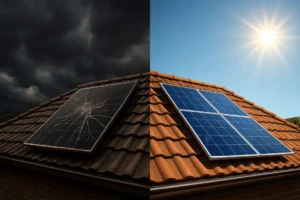
Is your solar system down? Have you noticed a leak, physical damage, or a sudden stop in power production? When your investment in clean energy
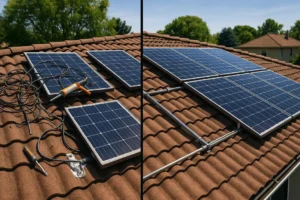
The idea of powering your home with the sun is exciting, and when it comes to making it a reality, you have two main paths:
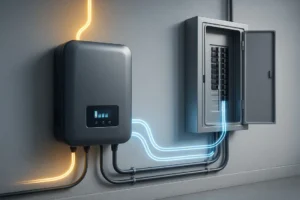
When planning a residential solar system, most of the attention goes to the sleek, dark panels on the roof. While panels are the face of
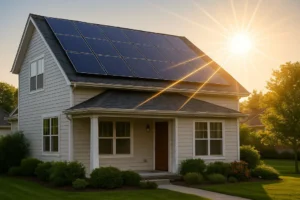
Harnessing the power of the sun to run your home might seem like science fiction, but it’s a practical and increasingly popular reality. Many homeowners

Choosing to go solar is a major investment in your home’s future. But once you’ve made that decision, you face an even bigger question: which

Diving into the world of residential solar energy can feel like learning a new language. You’ll encounter terms, standards, and rules of thumb that aren’t